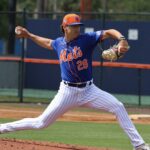
The Mets’ recent signing of Wilson Ramos benefits the club not only from the perspective of an everyday lineup, but also in terms of depth behind the plate. Once conflicted with a split core that compiled a 92 wRC+ last season, manager Mickey Callaway is now free to limit the tandem of Travis d’Arnaud and Kevin Plawecki to reserve roles, and as a result, general manager Brodie Van Wagenen has a chance to pawn one off in exchange for a reinforcement in either the outfield or bullpen.
It’s hard to dispute the fact that the offensive and defensive contributions of both catchers pail in comparison to those of Ramos over the past three seasons, as a .232/.308/.373 line and 20.7% caught-stealing rate in themselves justify the Mets’ decision to pursue a more competent starting option. But it has nonetheless been reported that both catchers have received significant interest from other teams. Moving on from either d’Arnaud (who is owed just $3.5MM next season) or Plawecki (who comes with another four years of team control) and bringing in a return is certainly realistic, and depending on the return, could definitely be worthwhile.
Ultimately, it should be noted that in past years, teams across the league have managed success despite limited to lousy production from their catchers. As a few points of reference, the World Series champion Boston Red Sox had the lowest catcher OPS (.547) among all 30 teams. The 2017 Houston Astros, also World Series champions, caught just 14 of 116 attempted base stealers – making for the league’s worst stolen base percentage (12%).
Likewise, one should bear in mind the sort of futility the Mets dealt with behind the plate over their last 51 games in 2018: a .193 average (13th in the NL), a .285 on-base percentage (12th), and .352 slugging percentage (13th) with a 21% caught-stealing rate. The Mets are unlikely to see much of a difference in the offensive department beyond the contributions of Ramos, and as the statistics can attest, that’s perfectly okay.
The Mets’ priority in marketing both catchers as trade bait should be finding the team most interested, and much less so finding a suitor for the “odd-man-out” in itself, seeing as the positive impact lies almost exclusively in what the Mets get back. If a team is willing to surrender an effective and cost-effective reliever, such as the San Francisco Giants’ Will Smith or the Los Angeles Angels’ Cam Bedrosian, the move should not hinge on who the Mets prefer as a backup catcher going forward. Between the team’s two options, Plawecki’s years of team control and newfound power stroke could be more attractive than d’Arnaud, who has consistently seen his potential as a hitter and defender take a backseat to injuries.
That said, the possibility of the Mets netting a substantial improvement in itself might be far-fetched, even with consideration to how weak the catching position has been across the board with the bat. If the Mets are to choose one backstop and take what they can get in exchange for the other, their decision should be made with consideration to what they will still need beyond Wilson Ramos’ capabilities. That is, the Mets should strive to compensate for that which Wilson Ramos will likely fall short in.
From this sort of angle, pitch framing and durability will be essential. D’Arnaud has a clear advantage over Plawecki in the former, as the 16.8 to 1.4 framing runs above average (respectively) since 2015 can confirm. Health, on the other hand, though a convenient place to cite d’Arnaud’s trouble staying on the field, may actually have more negative implications should the Mets choose Plawecki for the long haul. Though d’Arnaud is far more likely to see time on the disabled list next year, such a development would actually open up an opportunity for Tomas Nido to develop in a similar role as a pitcher whisperer.
Between his track record of hosing runners in the minor leagues (45% rate in Double-A Binghamton the past two years) as well as his demonstrated influence as a pitch-framer, Nido has flown under the radar in the conversation regarding the Mets’ catching situation. While his offense has been a question mark for some time, Nido should be viewed as a defensive weapon, most likely once a backup spot opens over the next few seasons. Hanging onto Kevin Plawecki, who has no minor league options remaining, would likely put a dent in the organization’s plans for Nido in 2019, thus depriving the Mets of a chance to offset the offensively-geared Ramos with a meticulous, resourceful glove that, in a few years’ time, may be more useful than Plawecki or d’Arnaud has been over the past three years.
Make no mistake, Nido’s future could very well be set in stone as a backup catcher and nothing else. Then again, the Mets would still cost themselves a chance at trying such an option out by rolling the dice on Plawecki, who has struggled to establish himself as a viable future option despite his contract and lack of options leaving the team with little choice.
Hanging onto Travis d’Arnaud would not separate the Mets from anyone on a competitive level in 2019, though it ultimately keeps things more flexible, and as a result, should be a priority for the organization should they try shipping out a backstop to fill another position.
















